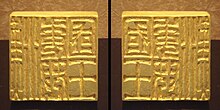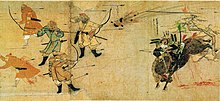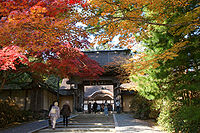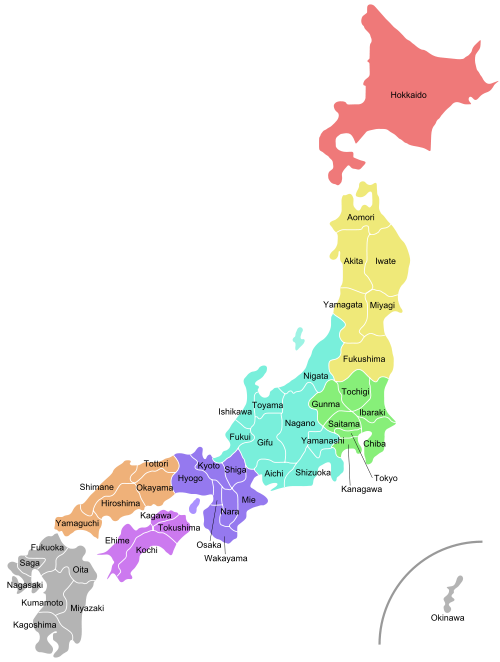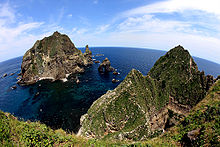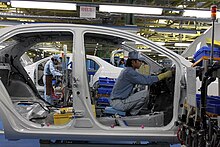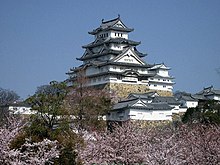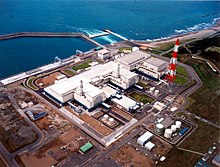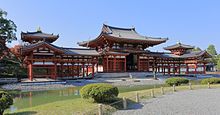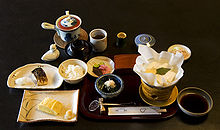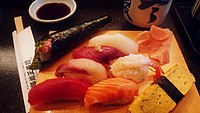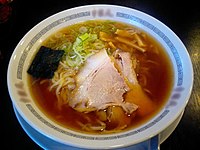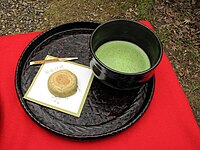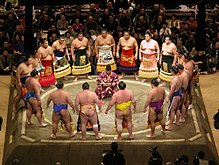| Japan
日本
Nippon or Nihon | |
|---|---|
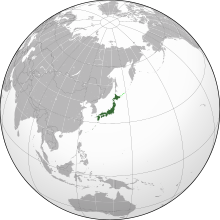
Area controlled by Japan shown in green—claimed, but uncontrolled shown in light green
| |
| Capital and largest city | Tokyo[4] 35°41′N 139°46′E |
| Official languages | None[5] |
| National language | Japanese[5] |
| Ethnic groups (2011)[6] | |
| Religion (2000)[7] |
|
| Demonym | Japanese |
| Government | Unitary dominant-party parliamentary constitutional monarchy |
• Emperor
| Akihito |
| Naruhito | |
| Shinzō Abe | |
| Tarō Asō | |
| Tadamori Oshima | |
| Chuichi Date | |
| Naoto Ōtani | |
| Legislature | National Diet |
| House of Councillors | |
| House of Representatives | |
| Formation | |
| February 11, 660 BCE[8] | |
| November 29, 1890 | |
| May 3, 1947 | |
| April 28, 1952 | |
| Area | |
• Total
| 377,972 km2 (145,936 sq mi)[9] (61st) |
• Water (%)
| 0.8 |
| Population | |
• 2017 census
| 126,672,000[10] (10th) |
• Density
| 336/km2 (870.2/sq mi) (36th) |
| GDP (PPP) | 2018 estimate |
• Total
| $5.619 trillion[11] (4th) |
• Per capita
| $44,426[11] (27th) |
| GDP (nominal) | 2018 estimate |
• Total
| $5.167 trillion[11] (3rd) |
• Per capita
| $40,849[11] (20th) |
| Gini (2011) | 37.9[12] medium · 76th |
| HDI (2015) | very high · 17th |
| Currency | Yen (¥) / En 円 (JPY) |
| Time zone | JST (UTC+9) |
• Summer (DST)
| not observed (UTC+9) |
| Date format | |
| Drives on the | left |
| Calling code | +81 |
| ISO 3166 code | JP |
| Internet TLD | .jp |
Website
www.japan.go.jp | |
| Japan | |
| Japanese name | |
|---|---|
| Kanji | 日本国 |
| Hiragana | にっぽんこく にほんこく |
| Katakana | ニッポンコク ニホンコク |
| Kyūjitai | 日本國 |
Archaeological research indicates that Japan was inhabited as early as the Upper Paleolithic period. The first written mention of Japan is in Chinese history texts from the 1st century AD. Influence from other regions, mainly China, followed by periods of isolation, particularly from Western Europe, has characterized Japan's history.
From the 12th century until 1868, Japan was ruled by successive feudal military shōguns who ruled in the name of the Emperor. Japan entered into a long period of isolation in the early 17th century, which was ended in 1853 when a United States fleet pressured Japan to open to the West. After nearly two decades of internal conflict and insurrection, the Imperial Court regained its political power in 1868 through the help of several clans from Chōshū and Satsuma—and the Empire of Japan was established. In the late 19th and early 20th centuries, victories in the First Sino-Japanese War, the Russo-Japanese War and World War I allowed Japan to expand its empire during a period of increasing militarism. The Second Sino-Japanese War of 1937 expanded into part of World War II in 1941, which came to an end in 1945 following the atomic bombings of Hiroshima and Nagasaki and the Japanese surrender. Since adopting its revised constitution on May 3, 1947, during the occupation by the SCAP, Japan has maintained a unitary parliamentary constitutional monarchy with an Emperor and an elected legislature called the National Diet.
Japan is a member of the ASEAN Plus mechanism, UN, the OECD, the G7, the G8 and the G20—and is considered a great power.[15][16][17] The country has the world's third-largest economy by nominal GDP and the world's fourth-largest economy by purchasing power parity. It is also the world's fourth-largest exporter and fourth-largest importer.
The country benefits from a highly skilled workforce and is among the most highly educated countries in the world, with one of the highest percentages of its citizens holding a tertiary education degree.[18] Although Japan has officially renounced its right to declare war, it maintains a modern military with the world's eighth-largest military budget,[19] used for self-defense and peacekeeping roles. Japan is a highly developed country with a very high standard of living and Human Development Index. Its population enjoys the highest life expectancy and the third lowest infant mortality rate in the world. Japan is renowned for its historical and extensive cinema, influential music industry, rich cuisine and its major contributions to science and modern-day technology.[20][21]
Etymology
The Japanese word for Japan is 日本, which is pronounced Nihon or Nippon and literally means "the origin of the sun". The character nichi (日) means "sun" or "day"; hon (本) means "base" or "origin".[22] The compound therefore means "origin of the sun" and is the source of the popular Western epithet "Land of the Rising Sun".[23]The earliest record of the name Nihon appears in the Chinese historical records of the Tang dynasty, the Old Book of Tang. At the end of the seventh century, a delegation from Japan requested that Nihon be used as the name of their country. This name may have its origin in a letter sent in 607 and recorded in the official history of the Sui dynasty. Prince Shōtoku, the Regent of Japan, sent a mission to China with a letter in which he called himself "the Emperor of the Land where the Sun rises" (日出處天子). The message said: "Here, I, the emperor of the country where the sun rises, send a letter to the emperor of the country where the sun sets. How are you[?]”.
The "King of Na gold seal", said to have been granted to Na king of Wa (Japan) by Emperor Guangwu of Han in 57 CE. The seal reads "漢委奴國王". Tokyo National Museum
Prior to the adoption of Nihon, other terms such as Yamato (大和, or "Great Wa") and Wakoku (倭国) were used. The term Wa (和) is a homophone of Wo 倭 (pronounced "Wa" by the Japanese), which has been used by the Chinese as a designation for the Japanese as early as the third century Three Kingdoms period. Another form of Wa (委, Wei in Chinese) was used for an early state in Japan called Nakoku during the Han dynasty.[24] However, the Japanese disliked some connotation of Wa 倭 (which has been associated in China with concepts like "dwarf" or "pygmy"), and it was therefore replaced with the substitute character Wa (和), meaning "togetherness, harmony".[25][26]
The English word Japan possibly derives from the historical Chinese pronunciation of 日本. The Old Mandarin or possibly early Wu Chinese pronunciation of Japan was recorded by Marco Polo as Cipangu. In modern Shanghainese, a Wu dialect, the pronunciation of characters 日本 Japan is Zeppen [zəʔpən]. The old Malay word for Japan, Japun or Japang, was borrowed from a southern coastal Chinese dialect, probably Fukienese or Ningpo[27]—and this Malay word was encountered by Portuguese traders in Southeast Asia in the 16th century.[28] These Early Portuguese traders then brought the word to Europe.[29] The first record of this name in English is in a book published in 1577 and spelled Giapan, in a translation of a 1565 letter written by a Portuguese Jesuit Luís Fróis.
From the Meiji Restoration until the end of World War II, the full title of Japan was Dai Nippon Teikoku (大日本帝國), meaning "the Empire of Great Japan".[32] Today, the name Nihon-koku/Nippon-koku (日本国) is used as a formal modern-day equivalent with the meaning of "the State of Japan". Countries like Japan whose long form does not contain a descriptive designation are generally given a name appended by the character koku (国), meaning "country", "nation" or "state".
History
Prehistory and ancient history
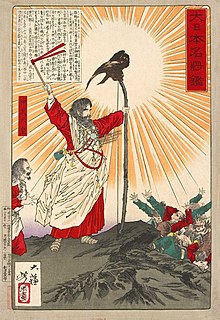
Emperor Jimmu (神武天皇 Jinmu-tennō), the first Emperor of Japan dated as 660 BCE[33][34][35] —in modern Japan his accession is marked as National Foundation Day on February 11
A Paleolithic culture around 30,000 BC constitutes the first known habitation of the Japanese archipelago. This was followed from around 14,000 BC (the start of the Jōmon period) by a Mesolithic to Neolithic semi-sedentary hunter-gatherer culture characterized by pit dwelling and rudimentary agriculture,[36] including by ancestors of contemporary Ainu people and Yamato people.[37][38] Decorated clay vessels from this period are some of the oldest surviving examples of pottery in the world. Around 300 BC, the Yayoi people began to enter the Japanese islands, intermingling with the Jōmon.[39] The Yayoi period, starting around 500 BC, saw the introduction of practices like wet-rice farming,[40] a new style of pottery[41] and metallurgy, introduced from China and Korea.[42]
Japan first appears in written history in the Chinese Book of Han.[43] According to the Records of the Three Kingdoms, the most powerful kingdom on the archipelago during the third century was called Yamataikoku. Buddhism was introduced to Japan from Baekje, Korea and was promoted by Prince Shōtoku, but the subsequent development of Japanese Buddhism was primarily influenced by China.[44] Despite early resistance, Buddhism was promoted by the ruling class and gained widespread acceptance beginning in the Asuka period (592–710).[45]
The Nara period (710–784) marked an emergence of the centralized Japanese state centered on the Imperial Court in Heijō-kyō (modern Nara). The Nara period is characterized by the appearance of a nascent literature as well as the development of Buddhist-inspired art and architecture.[46] The smallpox epidemic of 735–737 is believed to have killed as much as one-third of Japan's population.[47] In 784, Emperor Kanmu moved the capital from Nara to Nagaoka-kyō, then to Heian-kyō (modern Kyoto) in 794.
This marked the beginning of the Heian period (794–1185), during which a distinctly indigenous Japanese culture emerged, noted for its art, poetry and prose. Murasaki Shikibu's The Tale of Genji and the lyrics of Japan's national anthem "Kimigayo" were written during this time.[48]
Buddhism began to spread during the Heian era chiefly through two major sects, Tendai by Saichō and Shingon by Kūkai. Pure Land Buddhism (Jōdo-shū, Jōdo Shinshū) became greatly popular in the latter half of the 11th century.
Feudal era
Japan's feudal era was characterized by the emergence and dominance of a ruling class of warriors, the samurai. In 1185, following the defeat of the Taira clan in the Genpei War, sung in the epic Tale of Heike, samurai Minamoto no Yoritomo was appointed shōgun by Emperor Go-Toba, and Yoritomo established a base of power in Kamakura. After his death, the Hōjō clan came to power as regents for the shōguns. The Zen school of Buddhism was introduced from China in the Kamakura period (1185–1333) and became popular among the samurai class.[49] The Kamakura shogunate repelled Mongol invasions in 1274 and 1281, but was eventually overthrown by Emperor Go-Daigo. Emperor Go-Daigo was himself defeated by Ashikaga Takauji in 1336.
Samurais could kill a commoner for the slightest insult and were widely feared by the Japanese population. Edo period, 1798
Ashikaga Takauji established the shogunate in Muromachi, Kyoto. This was the start of the Muromachi period (1336–1573). The Ashikaga shogunate achieved glory at the age of Ashikaga Yoshimitsu, and the culture based on Zen Buddhism (the art of Miyabi) prospered. This evolved to Higashiyama Culture, and prospered until the 16th century. On the other hand, the succeeding Ashikaga shogunate failed to control the feudal warlords (daimyōs) and a civil war (the Ōnin War) began in 1467, opening the century-long Sengoku period ("Warring States").[50]
During the 16th century, traders and Jesuit missionaries from Portugal reached Japan for the first time, initiating direct commercial and cultural exchange between Japan and the West. This allowed Oda Nobunaga to obtain European technology and firearms, which he used to conquer many other daimyōs. His consolidation of power began what was known as the Azuchi–Momoyama period (1573–1603). After Nobunaga was assassinated in 1582 by Akechi Mitsuhide, his successor Toyotomi Hideyoshi unified the nation in 1590 and launched two unsuccessful invasions of Korea in 1592 and 1597.
Tokugawa Ieyasu served as regent for Hideyoshi's son and used his position to gain political and military support. When open war broke out, Ieyasu defeated rival clans in the Battle of Sekigahara in 1600. Tokugawa Ieyasu was appointed shōgun by Emperor Go-Yōzei in 1603 and established the Tokugawa shogunate in Edo (modern Tokyo).[51] The shogunate enacted measures including buke shohatto, as a code of conduct to control the autonomous daimyōs;[52] and in 1639 the isolationist sakoku ("closed country") policy that spanned the two and a half centuries of tenuous political unity known as the Edo period (1603–1868).[53] The study of Western sciences, known as rangaku, continued through contact with the Dutch enclave at Dejima in Nagasaki. The Edo period also gave rise to kokugaku ("national studies"), the study of Japan by the Japanese.[54]
Modern era
Emperor Meiji (1868–1912), in whose name imperial rule was restored at the end of the Tokugawa shogunate
On March 31, 1854, Commodore Matthew Perry and the "Black Ships" of the United States Navy forced the opening of Japan to the outside world with the Convention of Kanagawa. Subsequent similar treaties with Western countries in the Bakumatsu period brought economic and political crises. The resignation of the shōgun led to the Boshin War and the establishment of a centralized state nominally unified under the Emperor (the Meiji Restoration).[55]
Plunging itself through an active process of Westernization during the Meiji Restoration in 1868, Japan adopted Western political, judicial and military institutions and Western cultural influences integrated with its traditional culture for modern industrialization. The Cabinet organized the Privy Council, introduced the Meiji Constitution, and assembled the Imperial Diet. The Meiji Restoration transformed the Empire of Japan into an industrialized world power that pursued military conflict to expand its sphere of influence. Although France and Britain showed some interest, the European powers largely ignored Japan and instead concentrated on the much greater attractions of China. France was also set back by its failures in Mexico and defeat by the Germans.[56] After victories in the First Sino-Japanese War (1894–1895) and the Russo-Japanese War (1904–1905), Japan gained control of Taiwan, Korea and the southern half of Sakhalin.[57] In addition to imperialistic success, Japan also invested much more heavily in its own economic growth, leading to a period of economic flourishing in the country which lasted until the Great Depression.[58] Japan's population grew from 35 million in 1873 to 70 million in 1935.[59]
Chinese generals surrendering to the Japanese in the Sino-Japanese War of 1894–1895
In World War I, Japan joined the Allies and captured German possessions, and made advances into China. The early 20th century saw a period of Taishō democracy (1912–1926), but the 1920s saw a fragile democracy buckle under a political shift towards statism, the passing of laws against political dissent and a series of attempted coups. This process accelerated during the 1930s, spawning a number of new Radical Nationalist groups which shared a hostility to liberal democracy and a dedication to expansion in Asia. Japanese expansionism and militarization along with the totalitarianism and ultranationalism reshaped the country. In 1931 Japan invaded and occupied Manchuria and following international condemnation of this occupation, it quit the League of Nations in 1933. In 1936, Japan signed the Anti-Comintern Pact with Germany and the 1940 Tripartite Pact made it one of the Axis Powers.
Japanese officials surrendering to the Allies on September 2, 1945, in Tokyo Bay, ending World War II
The Empire of Japan invaded other parts of China in 1937, precipitating the Second Sino-Japanese War (1937–1945). The Imperial Japanese Army swiftly captured the capital Nanjing and conducted the Nanking Massacre.[60] In 1940, the Empire invaded French Indochina, after which the United States placed an oil embargo on Japan.[61] On December 7–8, 1941, Japanese forces carried out surprise attacks on Pearl Harbor, British forces in Malaya, Singapore and Hong Kong and declared war on the United States and the British Empire, bringing the United States and the United Kingdom into World War II in the Pacific. After Allied victories across the Pacific during the next four years, which culminated in the Soviet invasion of Manchuria and the atomic bombings of Hiroshima and Nagasaki in 1945, Japan agreed to an unconditional surrender on August 15.[62] The war cost Japan, its colonies, China and the war's other combatants tens of millions of lives and left much of Japan's industry and infrastructure destroyed. The Allies (led by the United States) repatriated millions of ethnic Japanese from colonies and military camps throughout Asia, largely eliminating the Japanese empire and restoring the independence of its conquered territories.[63] The Allies also convened the International Military Tribunal for the Far East on May 3, 1946, to prosecute some senior generals for war crimes.
In 1947, Japan adopted a new constitution emphasizing liberal democratic practices. The Allied occupation ended with the Treaty of San Francisco in 1952[64] and Japan was granted membership in the United Nations in 1956. Japan later achieved rapid growth to become the second-largest economy in the world, until surpassed by China in 2010. This ended in the mid-1990s when Japan suffered a major recession. In the beginning of the 21st century, positive growth has signaled a gradual economic recovery.[65] On March 11, 2011, Japan suffered one of the largest earthquakes in its recorded history; this triggered the Fukushima Daiichi nuclear disaster, one of the worst disasters in the history of nuclear power.[66]
Geography
Japanese archipelago as seen from satellite
Japan has a total of 6,852 islands extending along the Pacific coast of East Asia. The country, including all of the islands it controls, lies between latitudes 24° and 46°N, and longitudes 122° and 146°E. The main islands, from north to south, are Hokkaido, Honshu, Shikoku and Kyushu. The Ryukyu Islands, which include Okinawa, are a chain to the south of Kyushu. The Nanpō Islands are south of the main islands of Japan. Together they are often known as the Japanese archipelago.[67] As of 2006, Japan's territory is 377,923.1 km2 (145,916.9 sq mi) and, due to its many far-flung outlying islands, Japan has the eighth largest Exclusive Economic Zone in the world covering 4,470,000 km2 (1,730,000 sq mi).[68]
About 73 percent of Japan is forested, mountainous and unsuitable for agricultural, industrial or residential use.[6][69] As a result, the habitable zones, mainly located in coastal areas, have extremely high population densities. Japan is one of the most densely populated countries in the world.[70]
The islands of Japan are located in a volcanic zone on the Pacific Ring of Fire. They are primarily the result of large oceanic movements occurring over hundreds of millions of years from the mid-Silurian to the Pleistocene as a result of the subduction of the Philippine Sea Plate beneath the continental Amurian Plate and Okinawa Plate to the south, and subduction of the Pacific Plate under the Okhotsk Plate to the north. The Boso Triple Junction off the coast of Japan is a triple junction where the North American Plate, the Pacific Plate and the Philippine Sea Plate meets. Japan was originally attached to the eastern coast of the Eurasian continent. The subducting plates pulled Japan eastward, opening the Sea of Japan around 15 million years ago.[71]
Japan has 108 active volcanoes. During the twentieth century several new volcanoes emerged, including Shōwa-shinzan on Hokkaido and Myōjin-shō off the Bayonnaise Rocks in the Pacific. Destructive earthquakes, often resulting in tsunami, occur several times each century.[72] The 1923 Tokyo earthquake killed over 140,000 people.[73] More recent major quakes are the 1995 Great Hanshin earthquake and the 2011 Tōhoku earthquake, a 9.1-magnitude[74] quake which hit Japan on March 11, 2011, and triggered a large tsunami.[66] Japan is substantially prone to earthquakes, tsunami and volcanoes due to its location along the Pacific Ring of Fire.[75] It has the 15th highest natural disaster risk as measured in the 2013 World Risk Index.[76]
Climate
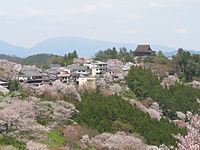
The climate of Japan is predominantly temperate, but varies greatly from north to south. Japan's geographical features divide it into six principal climatic zones: Hokkaido, Sea of Japan, Central Highland, Seto Inland Sea, Pacific Ocean, and Ryukyu Islands. The northernmost zone, Hokkaido, has a humid continental climate with long, cold winters and very warm to cool summers. Precipitation is not heavy, but the islands usually develop deep snowbanks in the winter.[77]
In the Sea of Japan zone on Honshu's west coast, northwest winter winds bring heavy snowfall. In the summer, the region is cooler than the Pacific area, though it sometimes experiences extremely hot temperatures because of the foehn. The Central Highland has a typical inland humid continental climate, with large temperature differences between summer and winter seasons, as well as large diurnal variation; precipitation is light, though winters are usually snowy. The mountains of the Chūgoku and Shikoku regions shelter the Seto Inland Sea from seasonal winds, bringing mild weather year-round.[77]
The Pacific coast features a humid subtropical climate that experiences milder winters with occasional snowfall and hot, humid summers because of the southeast seasonal wind. The Ryukyu Islands and Nanpō Islands have a subtropical climate, with warm winters and hot summers. Precipitation is very heavy, especially during the rainy season.[77]
The average winter temperature in Japan is 5.1 °C (41.2 °F) and the average summer temperature is 25.2 °C (77.4 °F).[78] The highest temperature ever measured in Japan 41.1 °C (106.0 °F) was recorded on July 23, 2018.[79] The main rainy season begins in early May in Okinawa, and the rain front gradually moves north until reaching Hokkaido in late July. In most of Honshu, the rainy season begins before the middle of June and lasts about six weeks. In late summer and early autumn, typhoons often bring heavy rain.[78]
Biodiversity
The Japanese macaques at Jigokudani hot spring are notable for visiting the spa in the winter
Japan has nine forest ecoregions which reflect the climate and geography of the islands. They range from subtropical moist broadleaf forests in the Ryūkyū and Bonin Islands, to temperate broadleaf and mixed forests in the mild climate regions of the main islands, to temperate coniferous forests in the cold, winter portions of the northern islands.[80] Japan has over 90,000 species of wildlife, including the brown bear, the Japanese macaque, the Japanese raccoon dog, the large Japanese field mouse, and the Japanese giant salamander.[81] A large network of national parks has been established to protect important areas of flora and fauna as well as thirty-seven Ramsar wetland sites.[82][83] Four sites have been inscribed on the UNESCO World Heritage List for their outstanding natural value.[84]
Environment
In the period of rapid economic growth after World War II, environmental policies were downplayed by the government and industrial corporations; as a result, environmental pollution was widespread in the 1950s and 1960s. Responding to rising concern about the problem, the government introduced several environmental protection laws in 1970.[85] The oil crisis in 1973 also encouraged the efficient use of energy because of Japan's lack of natural resources.[86] Current environmental issues include urban air pollution (NOx, suspended particulate matter, and toxics), waste management, water eutrophication, nature conservation, climate change, chemical management and international co-operation for conservation.[87]As of June 2015, more than 40 coal-fired power plants are planned or under construction in Japan. The NGO Climate Action Network announced Japan as the winner of its "Fossil of the Day" award for "doing the most to block progress on climate action".[88]
Japan ranks 20th in the 2018 Environmental Performance Index, which measures a nation's commitment to environmental sustainability.[89] As the host and signatory of the 1997 Kyoto Protocol, Japan is under treaty obligation to reduce its carbon dioxide emissions and to take other steps to curb climate change.[90]
Politics
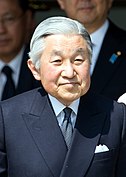 |

|
| Akihito Emperor since 1989 |
Shinzō Abe Prime Minister since 2012 |
Government
Japan is a constitutional monarchy whereby the power of the Emperor is very limited. As a ceremonial figurehead, he is defined by the constitution to be "the symbol of the State and of the unity of the people". Executive power is wielded chiefly by the Prime Minister and his cabinet, while sovereignty is vested in the Japanese people.[91]Japan's legislative body is the National Diet, seated in Chiyoda, Tokyo. The Diet is a bicameral body, comprising the lower House of Representatives with 465 seats, elected by popular vote every four years or when dissolved; and the upper House of Councillors with 242 seats, whose popularly elected members serve six-year terms. There is universal suffrage for adults over 18 years of age,[92] with a secret ballot for all elected offices.[91] The Diet is dominated by the social liberal Constitutional Democratic Party (CDP) and the conservative Liberal Democratic Party (LDP). The LDP has enjoyed near-continuous electoral success since 1955, except for brief periods between 1993 and 1994 and from 2009 to 2012. As of November 2017, it holds 283 seats in the lower house and 125 seats in the upper house.
The Prime Minister of Japan is the head of government and is appointed by the Emperor after being designated by the Diet from among its members. The Prime Minister is the head of the Cabinet, and appoints and dismisses the Ministers of State. Following the LDP's landslide victory in the 2012 general election, Shinzō Abe replaced Yoshihiko Noda as the Prime Minister on December 26, 2012.[93]
Historically influenced by Chinese law, the Japanese legal system developed independently during the Edo period through texts such as Kujikata Osadamegaki.[94] However, since the late 19th century the judicial system has been largely based on the civil law of Europe, notably Germany. For example, in 1896, the Japanese government established a civil code based on a draft of the German Bürgerliches Gesetzbuch; with the code remaining in effect with post–World War II modifications.[95] Statutory law originates in Japan's legislature and has the rubber stamp of the Emperor. Japan's court system is divided into four basic tiers: the Supreme Court and three levels of lower courts.[96] The main body of Japanese statutory law is called the Six Codes.[97]
Administrative divisions
Japan is divided into 47 prefectures, each overseen by an elected governor, legislature and administrative bureaucracy.[98] Each prefecture is further divided into cities, towns and villages.[99] The nation is currently undergoing administrative reorganization by merging many of the cities, towns and villages with each other. This process will reduce the number of sub-prefecture administrative regions and is expected to cut administrative costs.[100]Foreign relations
Japanese Prime Minister Shinzō Abe and U.S. President Donald Trump
The Liancourt Rocks known as Takeshima in Japan, has become an issue known as the Liancourt Rocks dispute
Japan has close ties to the United States. Since Japan's defeat by the United States and allies in World War II, the two countries have maintained close economic and defense relations. The United States is a major market for Japanese exports and the primary source of Japanese imports, and is committed to defending the country, having military bases in Japan for partially that purpose.[104]
Japan contests Russia's control of the Southern Kuril Islands (including Etorofu, Kunashiri, Shikotan, and the Habomai group) which were occupied by the Soviet Union in 1945.[105] South Korea's control of Liancourt Rocks (Japanese: Takeshima, Korean: Dokdo) are acknowledged, but not accepted and are claimed by Japan.[106] Japan has strained relations with the People's Republic of China (PRC) and the Republic of China (ROC) over the Senkaku Islands;[107] and with the People's Republic of China over the status of Okinotorishima.
Japan's relationship with South Korea has been strained due to Japan's treatment of Koreans during Japanese colonial rule, particularly over the issue of comfort women.[108] These women were essentially sex slaves, and although there is no exact number on how many women were subjected to this treatment, experts believe it could be in the tens or hundreds of thousands. Between 1910 and 1945, the Japanese government rebuilt Korean infrastructure. Despite this, modernization in Korea was always linked to Japanese interests and therefore did not imply a "revolutionization" of social structures. For instance, Japan kept Korea's primitive feudalistic agriculture because it served Japanese interests.[109] Further developments on Japan's imperialism in Korea included establishing a slew of police stations all over the country, replacing taxes in kind with taxes in fixed money, and taking much of the communal land which had belonged to villages to give them to private companies in Japan[110] (causing many peasants to loose their land.[111]) Japan also introduced over 800,000 Japanese immigrants onto the peninsula and carried out a campaign of cultural suppression through efforts to ban the Korean language in schools and force Koreans to adopt Japanese names.[112] With the surrender of Japan and the Axis at the end of WWII in 1945, the Korean Peninsula was once again independent. Despite their historical tensions, in December 2015, Japan agreed to settle the comfort women dispute with South Korea by issuing a formal apology, taking responsibility for the issue and paying money to the surviving comfort women. Today, South Korea and Japan have a stronger and more economically-driven relationship. Since the 1990s, the Korean Wave has created a large fanbase in East Asia, but most notably in Japan. Japan is the number one importer of Korean music (K-pop), television (K-dramas), and films, but this was only made possible after the South Korean government lifted the 30-year ban on cultural exchange with Japan that had been in place since 1948.[113] Korean pop cultural products' success in the Japanese market is partially explained by the borrowing of Japanese ideas such as the star-marketing system and heavy promotion of new television shows and music. Korean dramas such as Winter Sonata and Coffee Prince, as well as K-pop artists such as BIGBANG and SHINee are extremely popular with Japanese consumers. Most recently, South Korean President Moon Jae-in met with Japanese Prime Minister Shinzo Abe at the 2017 G-20 Summit in Hamburg, Germany to discuss the future of their relationship and specifically how to cooperate on finding solutions for North Korean aggression in the region. Both leaders restated their commitment to solving the comfort women dispute, building positive relations in the region, and pressuring China to be more assertive with North Korea as it continues to test nuclear weapons and isolate themselves further form the international community.[114]
Military
JDS Kongō (DDG-173), a guided missile destroyer, launching a Standard Missile 3 anti-ballistic missile in 2007
JASDF F-2, a multirole combat aircraft
Japan maintains one of the largest military budgets of any country in the world.[115] The country's military (the Japan Self-Defense Forces – JSDF) is restricted by Article 9 of the Japanese Constitution, which renounces Japan's right to declare war or use military force in international disputes. Accordingly, Japan's Self-Defense Forces is an unusual military that has never fired shots outside Japan.[116] Japan is the highest-ranked Asian country in the Global Peace Index.[117] The military is governed by the Ministry of Defense, and primarily consists of the Japan Ground Self-Defense Force (JGSDF), the Japan Maritime Self-Defense Force (JMSDF) and the Japan Air Self-Defense Force (JASDF). The Japan Maritime Self-Defense Force (JMSDF) is a regular participant in RIMPAC maritime exercises.[118] The forces have been recently used in peacekeeping operations; the deployment of troops to Iraq marked the first overseas use of Japan's military since World War II.[119] Japan Business Federation has called on the government to lift the ban on arms exports so that Japan can join multinational projects such as the Joint Strike Fighter.[120]
The 21st century is witnessing a rapid change in global power balance along with globalization. The security environment around Japan has become increasingly severe as represented by nuclear and missile development by North Korea. Transnational threats grounded on technological progress including international terrorism and cyber attacks are also increasing their significance.[121] Japan, including its Self-Defense Forces, has contributed to the maximum extent possible to the efforts to maintain and restore international peace and security, such as UN peacekeeping operations. Building on the ongoing efforts as a peaceful state, the Government of Japan has been making various efforts on its security policy which include: the establishment of the National Security Council (NSC), the adoption of the National Security Strategy (NSS), and the National Defense Program Guidelines (NDPG).[121] These efforts are made based on the belief that Japan, as a "Proactive Contributor to Peace", needs to contribute more actively to the peace and stability of the region and the international community, while coordinating with other countries including its ally, the United States.[121]
Japan has close economic and military relations with the United States; the US-Japan security alliance acts as the cornerstone of the nation's foreign policy.[122] A member state of the United Nations since 1956, Japan has served as a non-permanent Security Council member for a total of 20 years, most recently for 2009 and 2010. It is one of the G4 nations seeking permanent membership in the Security Council.[123]
In May 2014, Prime Minister Shinzō Abe said Japan wanted to shed the passiveness it has maintained since the end of World War II and take more responsibility for regional security. He said Japan wanted to play a key role and offered neighboring countries Japan's support.[124] In recent years, they have been engaged in international peacekeeping operations including the UN peacekeeping.[125] Recent tensions, particularly with North Korea,[126] have reignited the debate over the status of the JSDF and its relation to Japanese society.[127] New military guidelines, announced in December 2010, will direct the JSDF away from its Cold War focus on the former Soviet Union to a focus on China, especially regarding the territorial dispute over the Senkaku Islands.[128]
Economy
The Tokyo Stock Exchange, one of the largest stock exchanges in Asia[129]
Ginza, a luxury shopping area in Tokyo
Japan is the third largest national economy in the world, after the United States and China, in terms of nominal GDP,[130] and the fourth largest national economy in the world, after the United States, China and India, in terms of purchasing power parity. As of 2016, Japan's public debt was estimated at more than 230 percent of its annual gross domestic product, the largest of any nation in the world.[131] In August 2011, Moody's rating has cut Japan's long-term sovereign debt rating one notch from Aa3 to Aa2 inline with the size of the country's deficit and borrowing level. The large budget deficits and government debt since the 2009 global recession and followed by the earthquake and tsunami in March 2011 caused the rating downgrade.[132] The service sector accounts for three quarters of the gross domestic product.[133]
Japan has a large industrial capacity, and is home to some of the largest and most technologically advanced producers of motor vehicles, electronics, machine tools, steel and nonferrous metals, ships, chemical substances, textiles, and processed foods. Agricultural businesses in Japan cultivate 13 percent of Japan's land, and Japan accounts for nearly 15 percent of the global fish catch, second only to China.[6] As of 2016, Japan's labor force consisted of some 65.9 million workers.[6] Japan has a low unemployment rate of around four percent. Some 20 million people, around 17 per cent of the population, were below the poverty line in 2007.[134] Housing in Japan is characterized by limited land supply in urban areas.[135]
Japan's exports amounted to US$4,210 per capita in 2005. As of 2014, Japan's main export markets were the United States (20.2 percent), China (17.5 percent), South Korea (7.1 percent), Hong Kong (5.6 percent) and Thailand (4.5 percent). Its main exports are transportation equipment, motor vehicles, iron and steel products, semiconductors and auto parts.[6] Japan's main import markets as of 2015 were China (24.8 percent), the United States (10.5 percent), Australia (5.4 percent) and South Korea (4.1 percent).[6]
Japan's main imports are machinery and equipment, fossil fuels, foodstuffs (in particular beef), chemicals, textiles and raw materials for its industries. By market share measures, domestic markets are the least open of any OECD country.[136] Junichirō Koizumi's administration began some pro-competition reforms, and foreign investment in Japan has soared.[137]
Japan ranks 27th of 189 countries in the 2014 ease of doing business index and has one of the smallest tax revenues of the developed world. The Japanese variant of capitalism has many distinct features: keiretsu enterprises are influential, and lifetime employment and seniority-based career advancement are relatively common in the Japanese work environment.[136][138] Japanese companies are known for management methods like "The Toyota Way", and shareholder activism is rare.[139] Japan's top global brands include Toyota, Honda, Canon, Nissan, Sony, Mitsubishi UFJ (MUFG), Panasonic, Uniqlo, Lexus, Subaru, Nintendo, Bridgestone, Mazda and Suzuki.[140]
Economic history
Modern Japan's economic growth began in the Edo period. Some of the surviving elements of the Edo period are roads and water transportation routes, as well as financial instruments such as futures contracts, banking and insurance of the Osaka rice brokers.[141] During the Meiji period from 1868, Japan expanded economically with the embrace of the market economy.[142] Many of today's enterprises were founded at the time, and Japan emerged as the most developed nation in Asia.[143] The period of overall real economic growth from the 1960s to the 1980s has been called the Japanese post-war economic miracle: it averaged 7.5 percent in the 1960s and 1970s, and 3.2 percent in the 1980s and early 1990s.[144]Growth slowed in the 1990s during the "Lost Decade" due to after-effects of the Japanese asset price bubble and government policies intended to wring speculative excesses from the stock and real estate markets. Efforts to revive economic growth were unsuccessful and further hampered by the global slowdown in 2000.[6] The economy recovered after 2005; GDP growth for that year was 2.8 percent, surpassing the growth rates of the US and European Union during the same period.[145]
Today, Japan ranks highly for competitiveness and economic freedom. It is ranked sixth in the Global Competitiveness Report for 2015–2016.[146][147]
Agriculture and fishery
The Japanese agricultural sector accounts for about 1.4% of the total country's GDP.[148] Only 12% of Japan's land is suitable for cultivation.[149][150] Due to this lack of arable land, a system of terraces is used to farm in small areas.[151] This results in one of the world's highest levels of crop yields per unit area, with an overall agricultural self-sufficiency rate of about 50% on fewer than 56,000 square kilometres (14,000,000 acres) cultivated.
Japan's small agricultural sector, however, is also highly subsidized and protected, with government regulations that favor small-scale cultivation instead of large-scale agriculture as practiced in North America.[149] There has been a growing concern about farming as the current farmers are aging with a difficult time finding successors.[152]
Rice accounts for almost all of Japan's cereal production.[153] Japan is the second-largest agricultural product importer in the world.[153] Rice, the most protected crop, is subject to tariffs of 777.7%.
In 1996, Japan ranked fourth in the world in tonnage of fish caught.[155] Japan captured 4,074,580 metric tons of fish in 2005, down from 4,987,703 tons in 2000, 9,558,615 tons in 1990, 9,864,422 tons in 1980, 8,520,397 tons in 1970, 5,583,796 tons in 1960 and 2,881,855 tons in 1950.[156] In 2003, the total aquaculture production was predicted at 1,301,437 tonnes.[157] In 2010, Japan's total fisheries production was 4,762,469 fish.[158] Offshore fisheries accounted for an average of 50% of the nation's total fish catches in the late 1980s although they experienced repeated ups and downs during that period.
Today, Japan maintains one of the world's largest fishing fleets and accounts for nearly 15% of the global catch,[159] prompting some claims that Japan's fishing is leading to depletion in fish stocks such as tuna.[160] Japan has also sparked controversy by supporting quasi-commercial whaling.[161]
Industry
Toyota factory in Ohira, Miyagi Prefecture
Japan's industrial sector makes up approximately 27.5% of its GDP.[162] Japan's major industries are motor vehicles, electronics, machine tools, metals, ships, chemicals and processed foods; some major Japanese industrial companies include Toyota, Canon Inc., Toshiba and Nippon Steel.
Japan is the third largest automobile producer in the world, and is home to Toyota, the world's largest automobile company.[164][165] The Japanese consumer electronics industry, once considered the strongest in the world, is currently in a state of decline as competition arises in countries like South Korea, the United States and China.[166][167] However, despite also facing similar competition from South Korea and China, the Japanese shipbuilding industry is expected to remain strong due to an increased focus on specialized, high-tech designs.[168]
Services
Japan's service sector accounts for about three-quarters of its total economic output.[148] Banking, insurance, real estate, retailing, transportation, and telecommunications are all major industries, with companies such as Mitsubishi UFJ, Mizuho, NTT, TEPCO, Nomura, Mitsubishi Estate, ÆON, Mitsui Sumitomo, Softbank, JR East, Seven & I, KDDI and Japan Airlines listed as some of the largest in the world.[169][170] Four of the five most circulated newspapers in the world are Japanese newspapers.[171] Japan Post Holdings, one of the country's largest providers of savings and insurance services, was slated for privatization by 2015.[172] The six major keiretsus are the Mitsubishi, Sumitomo, Fuyo, Mitsui, Dai-Ichi Kangyo and Sanwa Groups.[173]Tourism
Tokyo Sky Tree, the tallest tower in the world
Japan attracted 19.73 million international tourists in 2015[174] and increased by 21.8% to attract 24.03 million international tourists in 2016.[175][176][177] Tourism from abroad is one of the few promising businesses in Japan. Foreign visitors to Japan doubled in last decade and reached 10 million people for the first time in 2013, led by increase of Asian visitors.
In 2008, the Japanese government has set up Japan Tourism Agency and set the initial goal to increase foreign visitors to 20 million in 2020. In 2016, having met the 20 million target, the government has revised up its target to 40 million by 2020 and to 60 million by 2030.[178][179]
Japan has 20 World Heritage Sites, including Himeji Castle, Historic Monuments of Ancient Kyoto and Nara.[180] Popular tourist attractions include Tokyo and Hiroshima, Mount Fuji, ski resorts such as Niseko in Hokkaido, Okinawa, riding the shinkansen and taking advantage of Japan's hotel and hotspring network.
For inbound tourism, Japan was ranked 16th in the world in 2015.[181] In 2009, the Yomiuri Shimbun published a modern list of famous sights under the name Heisei Hyakkei (the Hundred Views of the Heisei period). The Travel and Tourism Competitiveness Report 2017 ranks Japan 4th out of 141 countries overall, which was the best in Asia. Japan gained relatively high scores in almost all aspects, especially health and hygiene, safety and security, cultural resources and business travel.[182]
In 2016, 24,039,053 foreign tourists visited Japan.[183] Neighbouring South Korea is Japan's most important source of foreign tourists. In 2010, the 2.4 million arrivals made up 27% of the tourists visiting Japan.[184] Chinese travelers are the highest spenders in Japan by country, spending an estimated 196.4 billion yen (US$2.4 billion) in 2011, or almost a quarter of total expenditure by foreign visitors, according to data from the Japan Tourism Agency.[185]
The Japanese government hopes to receive 40 million foreign tourists every year by 2020.[186]
Science and technology
Kounotori 6 grappled by the International Space Station's robotic arm
Japan is a leading nation in scientific research, particularly in fields related to the natural sciences and engineering. The country ranks second among the most innovative countries in the Bloomberg Innovation Index.[187][188] Nearly 700,000 researchers share a US$130 billion research and development budget.[189] The amount spent on research and development relative to gross domestic product is the third highest in the world.[190] The country is a world leader in fundamental scientific research, having produced twenty-two Nobel laureates in either physics, chemistry or medicine[191] and three Fields medalists.[192]
Japanese scientists and engineers have contributed to the advancement of agricultural sciences, electronics, industrial robotics, optics, chemicals, semiconductors, life sciences and various fields of engineering. Japan leads the world in robotics production and use, possessing more than 20% (300,000 of 1.3 million) of the world's industrial robots as of 2013[193]—though its share was historically even higher, representing one-half of all industrial robots worldwide in 2000.[194] Japan boasts the third highest number of scientists, technicians, and engineers per capita in the world with 83 scientists, technicians and engineers per 10,000 employees.
Electronics and automotive engineering
A plug-in hybrid car manufactured by Toyota, one of the world's largest carmakers—Japan is the third-largest maker of automobiles in the world[164]
Sony Xperia phone
Japan has started a project to build the world's fastest supercomputer by the end of 2017.[199][needs update]
Aerospace
The Japanese Experiment Module (Kibo) at the International Space Station
The Japan Aerospace Exploration Agency (JAXA) is Japan's national space agency; it conducts space, planetary, and aviation research, and leads development of rockets and satellites. It is a participant in the International Space Station: the Japanese Experiment Module (Kibo) was added to the station during Space Shuttle assembly flights in 2008.[200] The space probe Akatsuki was launched May 20, 2010, and achieved orbit around Venus on December 9, 2015. Japan's plans in space exploration include: developing the Mercury Magnetospheric Orbiter to be launched in 2018;[201] and building a moon base by 2030.[202]
On September 14, 2007, it launched lunar explorer SELENE (Selenological and Engineering Explorer) on a H-IIA (Model H2A2022) carrier rocket from Tanegashima Space Center. SELENE is also known as Kaguya, after the lunar princess of The Tale of the Bamboo Cutter.[203] Kaguya is the largest lunar mission since the Apollo program. Its purpose is to gather data on the moon's origin and evolution. It entered a lunar orbit on October 4,[204][205] flying at an altitude of about 100 km (62 mi).[206] The probe's mission was ended when it was deliberately crashed by JAXA into the Moon on June 11, 2009.[207]
Nobel laureates
Japan has received the most science Nobel Prizes in Asia and ranked 8th in the world.[208] Hideki Yukawa, educated at Kyoto University, was awarded the prize in physics in 1949. Shin'ichirō Tomonaga followed in 1965. Solid-state physicist Leo Esaki, educated at the University of Tokyo, received the prize in 1973. Kenichi Fukui of Kyoto University shared the 1981 prize in chemistry, and Susumu Tonegawa, also educated at Kyoto University, became Japan's first laureate in physiology or medicine in 1987. Japanese chemists took prizes in 2000 and 2001: first Hideki Shirakawa (Tokyo Institute of Technology) and then Ryōji Noyori (Kyoto University). In 2002, Masatoshi Koshiba (University of Tokyo) and Koichi Tanaka (Tohoku University) won in physics and chemistry, respectively. Makoto Kobayashi, Toshihide Masukawa and Yoichiro Nambu, who was an American citizen when awarded, shared the physics prize and Osamu Shimomura also won the chemistry prize in 2008. Isamu Akasaki, Hiroshi Amano and Shuji Nakamura, who is an American citizen when awarded, shared the physics prize in 2014 and the Nobel Prize in Physiology or Medicine was awarded to Yoshinori Ohsumi in 2016.[209]Infrastructure
Transportation
Japan Airlines, flag carrier of Japan
Japan's road spending has been extensive.[210] Its 1.2 million kilometres (0.75 million miles) of paved road are the main means of transportation.[211] As of April 2012, Japan has approximately 1,215,000 kilometres (755,000 miles) of roads made up of 1,022,000 kilometres (635,000 miles) of city, town and village roads, 129,000 kilometres (80,000 miles) of prefectural roads, 55,000 kilometres (34,000 miles) of general national highways and 8,050 kilometres (5,000 miles) of national expressways.[212][213] A single network of high-speed, divided, limited-access toll roads connects major cities on Honshu, Shikoku and Kyushu. Hokkaido has a separate network, and Okinawa Island has a highway of this type. A single network of high-speed, divided, limited-access toll roads connects major cities and is operated by toll-collecting enterprises. New and used cars are inexpensive; car ownership fees and fuel levies are used to promote energy efficiency. However, at just 50 percent of all distance traveled, car usage is the lowest of all G8 countries.[214]
Since privatisation in 1987, dozens of Japanese railway companies compete in regional and local passenger transportation markets; major companies include seven JR enterprises, Kintetsu, Seibu Railway and Keio Corporation. Some 250 high-speed Shinkansen trains connect major cities and Japanese trains are known for their safety and punctuality.[215][216] Proposals for a new Maglev route between Tokyo and Osaka are at an advanced stage.[217]
There are 175 airports in Japan;[6] the largest domestic airport, Haneda Airport, is Asia's second-busiest airport.[218] The largest international gateways are Narita International Airport, Kansai International Airport and Chūbu Centrair International Airport.[219] Nagoya Port is the country's largest and busiest port, accounting for 10 percent of Japan's trade value.[220]
Energy
The Kashiwazaki-Kariwa Nuclear Power Plant, a nuclear plant with seven units, the largest single nuclear power station in the world
As of 2011, 46.1% of energy in Japan was produced from petroleum, 21.3% from coal, 21.4% from natural gas, 4.0% from nuclear power and 3.3% from hydropower. Nuclear power produced 9.2 percent of Japan's electricity, as of 2011, down from 24.9 percent the previous year.[221] However, by May 2012 all of the country's nuclear power plants had been taken offline because of ongoing public opposition following the Fukushima Daiichi nuclear disaster in March 2011, though government officials continued to try to sway public opinion in favor of returning at least some of Japan's 50 nuclear reactors to service.[222] As of November 2014, two reactors at Sendai are likely to restart in early 2015.[223] Japan lacks significant domestic reserves and so has a heavy dependence on imported energy.[224] Japan has therefore aimed to diversify its sources and maintain high levels of energy efficiency.[225]
Water supply and sanitation
Tokuyama Dam in Gifu Prefecture is the largest dam in Japan
The government took responsibility for regulating the water and sanitation sector is shared between the Ministry of Health, Labor and Welfare in charge of water supply for domestic use; the Ministry of Land, Infrastructure, Transport and Tourism in charge of water resources development as well as sanitation; the Ministry of the Environment in charge of ambient water quality and environmental preservation; and the Ministry of Internal Affairs and Communications in charge of performance benchmarking of utilities.[226]
Access to an improved water source is universal in Japan. 97% of the population receives piped water supply from public utilities and 3% receive water from their own wells or unregulated small systems, mainly in rural areas.[227]
Access to improved sanitation is also universal, either through sewers or on-site sanitation. All collected waste water is treated at secondary-level treatment plants. All effluents discharged to closed or semi-closed water bodies, such as Tokyo Bay, Osaka Bay, or Lake Biwa, are further treated to tertiary level. This applies to about 15% of waste water. The effluent quality is remarkably good at 3–10 mg/l of BOD for secondary-level treatment, well below the national effluent standard of 20 mg/l.
Water supply and sanitation in Japan is facing some challenges, such as a decreasing population, declining investment, fiscal constraints, ageing facilities, an ageing workforce, a fragmentation of service provision among thousands of municipal utilities, and the vulnerability of parts of the country to droughts that are expected to become more frequent due to climate change.
Demographics
Population
View of Tokyo
Ainu, an ethnic minority people from Japan
Japan's population is estimated at around 128 million,[228] with 80% of the population living on Honshū. Japanese society is linguistically, ethnically and culturally homogeneous,[229][230] composed of 98.5% ethnic Japanese,[6] with small populations of foreign workers.[229] Zainichi Koreans,[231] Chinese, Filipinos, Brazilians mostly of Japanese descent,[232] Peruvians mostly of Japanese descent and Americans are among the small minority groups in Japan.[233] In 2003, there were about 134,700 non-Latin American Western (not including more than 33,000 American military personnel and their dependents stationed throughout the country)[234] and 345,500 Latin American expatriates, 274,700 of whom were Brazilians (said to be primarily Japanese descendants, or nikkeijin, along with their spouses),[232] the largest community of Westerners.[235]
The most dominant native ethnic group is the Yamato people; primary minority groups include the indigenous Ainu[236] and Ryukyuan peoples, as well as social minority groups like the burakumin.[237] There are persons of mixed ancestry incorporated among the Yamato, such as those from Ogasawara Archipelago.[238] In 2014, foreign-born non-naturalized workers made up only 1.5% of the total population.[239] Japan is widely regarded as ethnically homogeneous, and does not compile ethnicity or race statistics for Japanese nationals; sources varies regarding such claim, with at least one analysis describing Japan as a multiethnic society[240] while another analysis put the number of Japanese nationals of recent foreign descent to be minimal.[230] Most Japanese continue to see Japan as a monocultural society. Former Japanese Prime Minister and current Finance Minister Tarō Asō described Japan as being a nation of "one race, one civilization, one language and one culture", which drew criticism from representatives of ethnic minorities such as the Ainu.[241]
Japan has the second longest overall life expectancy at birth of any country in the world: 83.5 years for persons born in the period 2010–2015.[21][242] The Japanese population is rapidly aging as a result of a post–World War II baby boom followed by a decrease in birth rates. In 2012, about 24.1 percent of the population was over 65, and the proportion is projected to rise to almost 40 percent by 2050.[243]
Religion
The torii of Itsukushima Shinto Shrine near Hiroshima, one of the Three Views of Japan and a UNESCO World Heritage Site
The Byōdō-in Buddhist temple, located in Uji, Kyoto
Shinto is the largest religion in Japan, practiced by nearly 80% of the population, yet only a small percentage of these identify themselves as "Shintoists" in surveys. This is due to the fact that "Shinto" has different meanings in Japan: most of the Japanese attend Shinto shrines and beseech kami without belonging to Shinto organisations, and since there are no formal rituals to become a member of folk Shinto, Shinto membership is often estimated counting those who join organised Shinto sects. Shinto has 100,000 shrines and 78,890 priests in the country.[248] Buddhism first arrived in Japan in the 6th century; it was introduced in the year 538 or 552[249] from the kingdom of Baekje in Korea.[249]
Christianity was first introduced into Japan by Jesuit missions starting in 1549.[250] Today, fewer than 1%[251][252][253] to 2.3% are Christians,[note 2] most of them living in the western part of the country, where the missionaries' activities were greatest during the 16th century. Nagasaki Prefecture has the highest percentage of Christians: about 5.1% in 1996.[254] As of 2007, there are 32,036 Christian priests and pastors in Japan.[248] Throughout the latest century, some Western customs originally related to Christianity (including Western style weddings, Valentine's Day and Christmas) have become popular as secular customs among many Japanese.[255]
Islam in Japan is estimated to constitute, about 80–90%, of foreign born migrants and their children, primarily from Indonesia, Pakistan, Bangladesh, and Iran.[256] Much of the ethnic Japanese Muslims are those who convert upon marrying immigrant Muslims.[257] The Pew Research Center estimated that there were 185,000 Muslims in Japan in 2010.[258]
Other minority religions include Hinduism, Sikhism and Judaism, Bahá'í Faith[259], and since the mid-19th century numerous new religious movements have emerged in Japan.[260]
Languages
More than 99 percent of the population speaks Japanese as their first language.[6] Japanese is an agglutinative language distinguished by a system of honorifics reflecting the hierarchical nature of Japanese society, with verb forms and particular vocabulary indicating the relative status of speaker and listener. Japanese writing uses kanji (Chinese characters) and two sets of kana (syllabaries based on cursive script and radical of kanji), as well as the Latin alphabet and Arabic numerals.[261]Besides Japanese, the Ryukyuan languages (Amami, Kunigami, Okinawan, Miyako, Yaeyama, Yonaguni), also part of the Japonic language family, are spoken in the Ryukyu Islands chain. Few children learn these languages,[262] but in recent years the local governments have sought to increase awareness of the traditional languages. The Okinawan Japanese dialect is also spoken in the region. The Ainu language, which has no proven relationship to Japanese or any other language, is moribund, with only a few elderly native speakers remaining in Hokkaido.[263] Public and private schools generally require students to take Japanese language classes as well as English language courses.[264][265]
Problems
The changes in demographic structure have created a number of social issues, particularly a potential decline in workforce population and increase in the cost of social security benefits such as the public pension plan.[266] A growing number of younger Japanese are not marrying or remain childless.[267] In 2011, Japan's population dropped for a fifth year, falling by 204,000 people to 126.24 million people. This was the greatest decline since at least 1947, when comparable figures were first compiled.[268] This decline was made worse by the March 2011 earthquake and tsunami, which killed nearly 16,000 people.[269]Japan's population is expected to drop to 95 million by 2050;[243][270] demographers and government planners are currently in a heated debate over how to cope with this problem.[267] Immigration and birth incentives are sometimes suggested as a solution to provide younger workers to support the nation's ageing population.[271][272] Japan accepts an average flow of 9,500 new Japanese citizens by naturalization per year.[273] According to the UNHCR, in 2012 Japan accepted just 18 refugees for resettlement,[274] while the United States took in 76,000.[275]
Japan suffers from a high suicide rate.[276][277] In 2009, the number of suicides exceeded 30,000 for the twelfth successive year.[278] Suicide is the leading cause of death for people under 30.[279]
Education
Students celebrating after the announcement of the results of the entrance examinations to the University of Tokyo
Primary schools, secondary schools and universities were introduced in 1872 as a result of the Meiji Restoration.[280] Since 1947, compulsory education in Japan comprises elementary and junior high school, which together last for nine years (from age 6 to age 15). Almost all children continue their education at a three-year senior high school.
Japan's education system played a central part in the country's recovery and rapid economic growth in the decades following the end of World War II. After World War II, the Fundamental Law of Education and the School Education Law were enacted. The latter law defined the school system that would be in effect for many decades: six years of elementary school, three years of junior high school, three years of high school, and two or four years of university. Starting in April 2016, various schools began the academic year with elementary school and junior high school integrated into one nine-year compulsory schooling program, in hopes to mitigate bullying and truancy; MEXT plans for this approach to be adopted nationwide in the coming years.[281] In Japan, having a strong educational background greatly improves the likelihood of finding a job and earning enough money to support oneself. Highly educated individuals are less affected by unemployment trends as higher levels of educational attainment make an individual more attractive in the workforce. The lifetime earnings also increase with each level of education attained. Furthermore, skills needed in the modern 21st century labor market are becoming more knowledge-based and strong aptitude in science and mathematics are more strong predictors of employment prospects in Japan's highly technological economy.[282]
Japan is one of the top-performing OECD countries in reading literacy, maths and sciences with the average student scoring 540 and has one of the worlds highest-educated labor forces among OECD countries.[283] The Japanese populace is well educated and its society highly values education as a platform for social mobility and for gaining employment in the country's competitive high-tech economy. The country's large pool of highly educated and skilled individuals is largely responsible for ushering Japan's post-war economic growth. Tertiary-educated adults in Japan, particularly graduates in sciences and engineering benefit economically and socially from their education and skills in the country's high tech economy.[282] Spending on education as a proportion of GDP is below the OECD average. Although expenditure per student is comparatively high in Japan, total expenditure relative to GDP remains small.[282] In 2015, Japan's public spending on education amounted to just 3.5 percent of its GDP, below the OECD average of 4.7%.[284] In 2014, the country ranked fourth for the percentage of 25- to 64-year-olds that have attained tertiary education with 48 percent. In addition, bachelor's degrees are held by 59 percent of Japanese aged 25–34, the second most in the OECD after South Korea.[18] As the Japanese economy is largely scientific and technological based, the labor market demands people who have achieved some form of higher education, particularly related to science and engineering in order to gain a competitive edge when searching for employment opportunities. About 75.9 percent of high school graduates attended a university, junior college, trade school, or other higher education institution.[285]
The two top-ranking universities in Japan are the University of Tokyo and Kyoto University,[286][287] which have produced 16 Nobel Prize laureates. The Programme for International Student Assessment coordinated by the OECD currently ranks the overall knowledge and skills of Japanese 15-year-olds as sixth best in the world.[288]
Health
In Japan, health care is provided by national and local governments. Payment for personal medical services is offered through a universal health insurance system that provides relative equality of access, with fees set by a government committee. People without insurance through employers can participate in a national health insurance program administered by local governments. Since 1973, all elderly persons have been covered by government-sponsored insurance.[289] Patients are free to select the physicians or facilities of their choice.[290]Culture
Japanese culture has evolved greatly from its origins. Contemporary culture combines influences from Asia, Europe and North America. Traditional Japanese arts include crafts such as ceramics, textiles, lacquerware, swords and dolls; performances of bunraku, kabuki, noh, dance, and rakugo; and other practices, the tea ceremony, ikebana, martial arts, calligraphy, origami, onsen, Geisha and games. Japan has a developed system for the protection and promotion of both tangible and intangible Cultural Properties and National Treasures.[291] Nineteen sites have been inscribed on the UNESCO World Heritage List, fifteen of which are of cultural significance.[84]Architecture
Kinkaku-ji or "The Temple of the Golden Pavilion" in Kyoto, Special Historic Site, Special Place of Scenic Beauty and a UNESCO World Heritage Site, whose torching by a monk in 1950 is the subject of a novel by Mishima
Japanese architecture is a combination between local and other influences. It has traditionally been typified by wooden structures, elevated slightly off the ground, with tiled or thatched roofs. Sliding doors (fusuma) were used in place of walls, allowing the internal configuration of a space to be customized for different occasions. People usually sat on cushions or otherwise on the floor, traditionally; chairs and high tables were not widely used until the 20th century. Since the 19th century, however, Japan has incorporated much of Western, modern, and post-modern architecture into construction and design, and is today a leader in cutting-edge architectural design and technology.
The introduction of Buddhism during the sixth century was a catalyst for large-scale temple building using complicated techniques in wood. Influence from the Chinese Tang and Sui dynasties led to the foundation of the first permanent capital in Nara. Its checkerboard street layout used the Chinese capital of Chang'an as a template for its design. A gradual increase in the size of buildings led to standard units of measurement as well as refinements in layout and garden design. The introduction of the tea ceremony emphasised simplicity and modest design as a counterpoint to the excesses of the aristocracy.
During the Meiji Restoration of 1868 the history of Japanese architecture was radically changed by two important events. The first was the Kami and Buddhas Separation Act of 1868, which formally separated Buddhism from Shinto and Buddhist temples from Shinto shrines, breaking an association between the two which had lasted well over a thousand years.[292]
Second, it was then that Japan underwent a period of intense Westernization in order to compete with other developed countries. Initially architects and styles from abroad were imported to Japan but gradually the country taught its own architects and began to express its own style. Architects returning from study with western architects introduced the International Style of modernism into Japan. However, it was not until after the Second World War that Japanese architects made an impression on the international scene, firstly with the work of architects like Kenzō Tange and then with theoretical movements like Metabolism.
Art
The Shrines of Ise have been celebrated as the prototype of Japanese architecture.[293] Largely of wood, traditional housing and many temple buildings see the use of tatami mats and sliding doors that break down the distinction between rooms and indoor and outdoor space.[294] Japanese sculpture, largely of wood, and Japanese painting are among the oldest of the Japanese arts, with early figurative paintings dating back to at least 300 BC. The history of Japanese painting exhibits synthesis and competition between native Japanese aesthetics and adaptation of imported ideas.[295]The interaction between Japanese and European art has been significant: for example ukiyo-e prints, which began to be exported in the 19th century in the movement known as Japonism, had a significant influence on the development of modern art in the West, most notably on post-Impressionism.[295] Famous ukiyo-e artists include Hokusai and Hiroshige.
Japanese comics, known as manga, developed in the 20th century and have become popular worldwide.[296] Rakuten Kitazawa was first to use the word "manga" in the modern sense.[297] Japanese-made video game consoles have been popular since the 1980s.[298]
- Example of Japanese calligraphy (書道 shodō)
Godzilla (Ishirō Honda, 1954)
Animation
Japanese animated films and television series, known as anime for short, were largely influenced by Japanese manga comic books and have been extensively popular in the West. Japan is a world-renowned powerhouse of animation.[299] Famous anime directors include Hayao Miyazaki, Osamu Tezuka and Isao Takahata.Cinema
Japan has one of the oldest and largest film industries in the world; movies have been produced in Japan since 1897.[300] Three Japanese films (Rashomon, Seven Samurai and Tokyo Story) made the Sight & Sound's 2002 Critics and Directors Poll for the best films of all time.[301] Ishirō Honda's Godzilla became an international icon of Japan and spawned an entire subgenre of kaiju films, as well as the longest-running film franchise in history. The most acclaimed Japanese film directors include Akira Kurosawa, Kenji Mizoguchi, Yasujiro Ozu and Shohei Imamura. Japan has won the Academy Award for the Best Foreign Language Film four times, more than any other Asian country.Music
Masayo Ishigure playing 13-strings Koto
Japanese music is eclectic and diverse. Many instruments, such as the koto, were introduced in the 9th and 10th centuries. The accompanied recitative of the Noh drama dates from the 14th century and the popular folk music, with the guitar-like shamisen, from the sixteenth.[302] Western classical music, introduced in the late 19th century, now forms an integral part of Japanese culture. The imperial court ensemble Gagaku has influenced the work of some modern Western composers.[303]
Notable classical composers from Japan include Toru Takemitsu and Rentarō Taki. Popular music in post-war Japan has been heavily influenced by American and European trends, which has led to the evolution of J-pop, or Japanese popular music.[304] Karaoke is the most widely practiced cultural activity in Japan. A 1993 survey by the Cultural Affairs Agency found that more Japanese had sung karaoke that year than had participated in traditional pursuits such as flower arranging (ikebana) or tea ceremonies.[305]
Literature
The earliest works of Japanese literature include the Kojiki and Nihon Shoki chronicles and the Man'yōshū poetry anthology, all from the 8th century and written in Chinese characters.[306][307] In the early Heian period, the system of phonograms known as kana (hiragana and katakana) was developed. The Tale of the Bamboo Cutter is considered the oldest Japanese narrative.[308] An account of Heian court life is given in The Pillow Book by Sei Shōnagon, while The Tale of Genji by Murasaki Shikibu is often described as the world's first novel.[309][310]
During the Edo period, the chōnin ("townspeople") overtook the samurai aristocracy as producers and consumers of literature. The popularity of the works of Saikaku, for example, reveals this change in readership and authorship, while Bashō revivified the poetic tradition of the Kokinshū with his haikai (haiku) and wrote the poetic travelogue Oku no Hosomichi.[311] The Meiji era saw the decline of traditional literary forms as Japanese literature integrated Western influences. Natsume Sōseki and Mori Ōgai were the first "modern" novelists of Japan, followed by Ryūnosuke Akutagawa, Jun'ichirō Tanizaki, Yukio Mishima and, more recently, Haruki Murakami. Japan has two Nobel Prize-winning authors—Yasunari Kawabata (1968) and Kenzaburō Ōe (1994).[308]
Philosophy
Kitaro Nishida, one of the most notable Japanese philosophers
Japanese Philosophy has historically been a fusion of both foreign; particularly Chinese and Western, and uniquely Japanese elements. In its literary forms, Japanese philosophy began about fourteen centuries ago.
Archaeological evidence and early historical accounts suggest that Japan was originally an animistic culture, which viewed the world as infused with kami (神) or sacred presence as taught by Shinto, though it is not a philosophy as such, but has greatly influenced all other philosophies in their Japanese interpretations.[312]
Confucianism entered Japan from China around the 5th century A.D., as did Buddhism.[313] Confucian ideals are still evident today in the Japanese concept of society and the self, and in the organization of the government and the structure of society.[313] Buddhism has profoundly impacted Japanese psychology, metaphysics, and aesthetics.[314]
Indigenous ideas of loyalty and honour have been held since the 16th century. Western philosophy has had its major impact in Japan only since the middle of the 19th century.
Cuisine
Breakfast at a ryokan or inn
Maiko preparing teacups for tea ceremony
Japanese cuisine is based on combining staple foods, typically Japanese rice or noodles, with a soup and okazu—dishes made from fish, vegetable, tofu and the like—to add flavor to the staple food. In the early modern era ingredients such as red meats that had previously not been widely used in Japan were introduced. Japanese cuisine is known for its emphasis on seasonality of food,[315] quality of ingredients and presentation. Japanese cuisine offers a vast array of regional specialties that use traditional recipes and local ingredients. The phrase ichijū-sansai (一汁三菜, "one soup, three sides") refers to the makeup of a typical meal served, but has roots in classic kaiseki, honzen, and yūsoku cuisine. The term is also used to describe the first course served in standard kaiseki cuisine nowadays.[316]
Traditional Japanese sweets are known as wagashi. Ingredients such as red bean paste and mochi are used. More modern-day tastes includes green tea ice cream, a very popular flavor. Almost all manufacturers produce a version of it. Kakigori is a shaved ice dessert flavored with syrup or condensed milk. It is usually sold and eaten at summer festivals. Popular Japanese beverages such as sake, which is a brewed rice beverage that, typically, contains 15%~17% alcohol and is made by multiple fermentation of rice. Beer has been brewed in Japan since the late 1800s and is produced in many regions by companies including Asahi Breweries, Kirin Brewery, and Sapporo Brewery – the oldest brand of beer in Japan.
Holidays
Officially, Japan has 16 national, government-recognized holidays. Public holidays in Japan are regulated by the Public Holiday Law (国民の祝日に関する法律 Kokumin no Shukujitsu ni Kansuru Hōritsu) of 1948.[317] Beginning in 2000, Japan implemented the Happy Monday System, which moved a number of national holidays to Monday in order to obtain a long weekend. In 2006, the country decided to add Shōwa Day, a new national holiday, in place of Greenery Day on April 29, and to move Greenery Day to May 4. These changes took effect in 2007. In 2014, the House of Councillors decided to add Mountain Day (山の日 Yama no Hi) to the Japanese calendar on August 11, after lobbying by the Japanese Alpine Club. It is intended to coincide with the Bon Festival vacation time, giving Japanese people an opportunity to appreciate Japan's mountains.[318][319]
The national holidays in Japan are New Year's Day on January 1, Coming of Age Day on Second Monday of January, National Foundation Day on February 11, Vernal Equinox Day on March 20 or 21, Shōwa Day on April 29, Constitution Memorial Day on May 3, Greenery Day on May 4, Children's Day on May 5, Marine Day on Third Monday of July, Mountain Day on August 11, Respect for the Aged Day on Third Monday of September, Autumnal Equinox on September 23 or 24, Health and Sports Day on Second Monday of October, Culture Day on November 3, Labour Thanksgiving Day on November 23, and The Emperor's Birthday on December 23.[320]
Festivals
There are many festivals in Japan, which are called in Japanese as matsuri (祭) which celebrate annually. There are no specific festival days for all of Japan; dates vary from area to area, and even within a specific area, but festival days do tend to cluster around traditional holidays such as Setsubun or Obon. Festivals are often based around one event, with food stalls, entertainment, and carnival games to keep people entertained. Its usually sponsored by a local shrine or temple, though they can be secular.[321]
Notable festival often feature processions which may include elaborate floats. Preparation for these processions is usually organised at the level of neighborhoods, or machi (町). Prior to these, the local kami may be ritually installed in mikoshi and paraded through the streets, such as Gion in Kyoto, and Hadaka in Okayama.[321]
Sports
Sumo wrestlers form around the referee during the ring-entering ceremony
Traditionally, sumo is considered Japan's national sport.[322] Japanese martial arts such as judo, karate and kendo are also widely practiced and enjoyed by spectators in the country. After the Meiji Restoration, many Western sports were introduced in Japan and began to spread through the education system.[323]
Japan hosted the Summer Olympics in Tokyo in 1964 and the Winter Olympics in Sapporo in 1972 and Nagano in 1998.[324] Further, the country hosted the official 2006 Basketball World Championship.[325] Tokyo will host the 2020 Summer Olympics, making Tokyo the first Asian city to host the Olympics twice.[326] The country gained the hosting rights for the official Women's Volleyball World Championship on five occasions (1967, 1998, 2006, 2010, 2018), more than any other nation.[327] Japan is the most successful Asian Rugby Union country, winning the Asian Five Nations a record 6 times and winning the newly formed IRB Pacific Nations Cup in 2011. Japan will host the 2019 IRB Rugby World Cup.[328]
Baseball is currently the most popular spectator sport in the country. Japan's top professional league, now known as Nippon Professional Baseball, was established in 1936[329] and is widely considered to be the highest level of professional baseball in the world outside of the North American Major Leagues. Since the establishment of the Japan Professional Football League in 1992, association football has also gained a wide following.[330] Japan was a venue of the Intercontinental Cup from 1981 to 2004 and co-hosted the 2002 FIFA World Cup with South Korea.[331] Japan has one of the most successful football teams in Asia, winning the Asian Cup four times.[332] Also, Japan recently won the FIFA Women's World Cup in 2011.[333] Golf is also popular in Japan,[334] as are forms of auto racing like the Super GT series and Formula Nippon.[335] The country has produced one NBA player, Yuta Tabuse.[336]
Media
Television and newspapers take an important role in Japanese mass media, though radio and magazines also take a part.[337][338] For a long time, newspapers were regarded as the most influential information medium in Japan, although audience attitudes towards television changed with the emergence of commercial news broadcasting in the mid-1980s.[337] Over the last decade, television has clearly come to surpass newspapers as Japan's main information and entertainment medium.[339]
There are 6 nationwide television networks: NHK (public broadcasting), Nippon Television (NTV), Tokyo Broadcasting System (TBS), Fuji Network System (FNS), TV Asahi (EX) and TV Tokyo Network (TXN).[338] For the most part, television networks were established based on capital investments by existing radio networks. Variety shows, serial dramas, and news constitute a large percentage of Japanese television show. According to the 2015 NHK survey on television viewing in Japan, 79 percent of Japanese watch television every day. The average daily duration of television viewing was three hours.[340]
Japanese readers have a choice of approximately 120 daily newspapers with a total of 50 million copies of set paper with an average subscription rate of 1.13 newspapers per household.[341] The main newspaper's publishers are Yomiuri Shimbun, Asahi Shimbun, Mainichi Shimbun, Nikkei Shimbun and Sankei Shimbun. According to a survey conducted by the Japanese Newspaper Association in June 1999, 85.4 per cent of men and 75 per cent of women read a newspaper every day. Average daily reading times vary with 27.7 minutes on weekdays and 31.7 minutes on holidays and Sunday.
![Centered deep red circle on a white rectangle[1]](https://upload.wikimedia.org/wikipedia/en/thumb/9/9e/Flag_of_Japan.svg/125px-Flag_of_Japan.svg.png)



